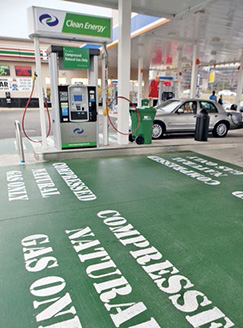Natural Gas and Climate change



Natural gas is an energy source that can guarantee a pathway to efficient and effective decarbonisation at a national and European level. Snam is investing to develop the infrastructures necessary to enhance the security of energy supplies, making Italy the European gas hub, to facilitate the creation of an European market and to promote the use of compressed natural gas in the transportation sector, to increase the use of liquefied natural gas and biomethane.
The Sustainability of natural gas
For a given amount of energy used, the combustion of natural gas produces between 25% and 40% less carbon dioxide than other fossil fuels, and is free of particulates
Future scenarios elaborated by the International Energy Agency (IEA) see the economic and population growth of the emerging countries to be the major factors that will feed energy demand at a worldwide level, of which China, India and other Asian countries will absorb about 80% of the expected increase in 2040. Within this context, natural gas will continue to play a leading role in the evolution of the energy mix, though playing different roles in different geographic settings.
If in fact the main role of natural gas in non-OECD countries will be to support the economic development, supplementing coal and oil, in Europe and in Italy, where it already is a significant part of the energy mix, it can help achieve the objective of ensuring a progressive decarbonisation together with non-programmable renewable energy sources such as wind and photovoltaic. A greater use of natural gas means fighting climate change and would also result in lower emissions of sulphur dioxide, nitrogen oxides and soot, with a decisive impact on the air pollution abatement measures in the cities.
Natural gas will also be an increasingly accessible source of energy, given the presence of large reserves in the areas close to Europe and the growth of the worldwide liquefied natural gas market, which has increased the availability of natural gas at reduced prices. In this context, the existing network of infrastructures for transportation, storage and distribution, and those in the process of development and construction, will make Italy the European gas hub, ensuring flexibility, programmability and affordability for its energy system. This is also due to a gas-fuelled electricity generation capacity that is already widely available and extremely efficient.
Sustainable mobility (CNG-LNG)

Within the framework of the initiatives implemented in favour of sustainable mobility, Snam published an EU Call For Tenders in 2017 for the renewal of its fleet of cars (approx. 1,500 vehicles), most of which are powered by methane and also signed agreements with the main car manufacturers to provide employees and their family members with discounts to purchase methane-powered cars.
Snam firmly believes that compressed natural gas (CNG) is a valid alternative to traditional automobile fuels.
The use of CNG instead of gasoline and diesel fuel not only reduces CO2 emissions, the main cause of greenhouse effect and global warming, but also approx. 94% of nitrogen oxide (NOx) emissions, the cause of “acid rain”, and up to 95% of the particulate emissions (including PM10 AND PM2.5) which are the most harmful to health.
In addition to reducing the emission of pollutants into the atmosphere, an additional indirect benefit comes from the extensive widespread network of gas pipelines which allows the transportation of fuel without any impact on the traffic from the perspective of safety and environmental protection.
Through its subsidiary Snam4Mobility, Snam is committed to developing the infrastructure for the use of natural gas in the transportation sector. In particular, in 2017 it signed the first agreements with different counterparts to develop 19 fuel stations (1 LNG and 18 CNG stations), of which a first group of 14 within the national ENI network of gas stations. Snam’s goal is to create over 250 new distributors on a national scale, which will add to the approximately 1,000 currently existing distributors, to better balance the deployment in the different regions of the Country.
Liquefied Natural Gas (LNG), in addition to being a key element to ensure a greater energy security and diversification of supply, is also an affordable and efficient solution to reduce the emissions produced from the land and sea transportation. The extension also into the Mediterranean Sea, of the Emission Control Areas (ECAs) law, which limits the emissions of sulphur oxides, and it could also significantly contribute to the development of LNG as maritime fuel.
The resumption of the regasification in Italy, which in 2017 saw 8.38 billion cubic metres of natural gas (+30% compared to 2016) injected into the network, is also a demonstration of the increasing attention being given to the LNG.
Italy’s currently available regasification capacity, however, is still insufficient to attract new LNG flows and this hinders the exploitation of resources coming from the United States, Africa and the Middle East, for example.
Strengthening the infrastructure in this area, with particular attention to upgrading the terminals and constructing deposits on the coast, would also fully promote the role of alternative fuels instead of the conventional ones.
Biomethane, a current reality and opportunity for the future

Biomethane is already a reality for the Snam’s network: in 2017, the first biomethane production plant was connected to the network and an additional 13 contracts were stipulated to build new delivery points.
Biomethane is a renewable and programmable source that supplements solar and wind energy sources. It is obtained in special plants, from the anaerobic digestion of agricultural and agro-industry by-products through a biogas upgrading process. It is ready for injection into the network and it is used in all the industries where the gas is present, also in the road transport.
Italy, with 1,500 anaerobic digestion plants in operation, is currently the third largest producer in the world of biogas from agricultural matrices with approximately 2.4 billion cubic metres per year.
Biomethane’s contribution to the decarbonisation goals is not only limited to the energy consumption phase. Its production process can help significantly reduce the emissions of the agricultural sector and return organic substance to the soil with a philosophy of the circular economy: what remains after the anaerobic digestion process on agricultural matrices is in fact an excellent natural fertiliser.
Snam supports the biomethane chain in Italy together with the Italian Biogas Consortium and Confagricoltura with whom it drafted a manifesto presented at the 2016 edition of Biogas Italy.